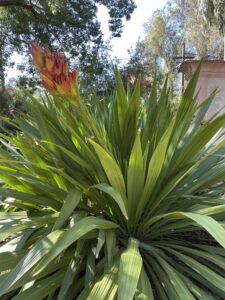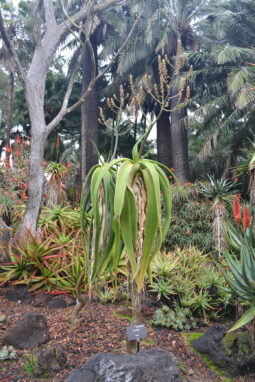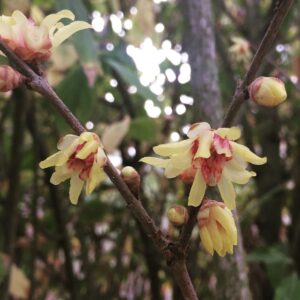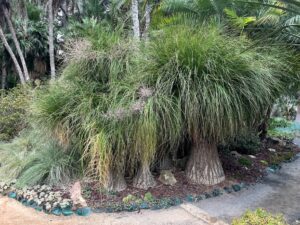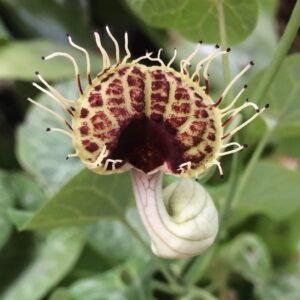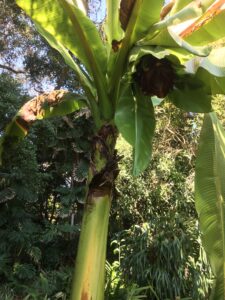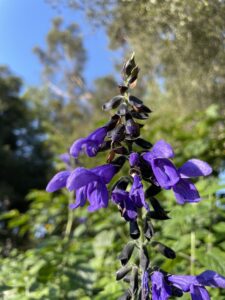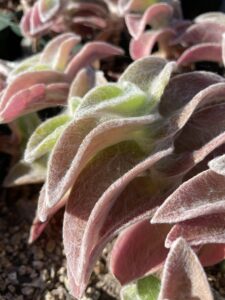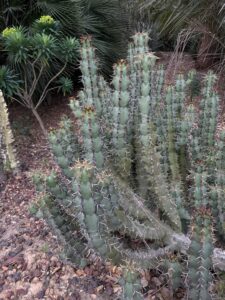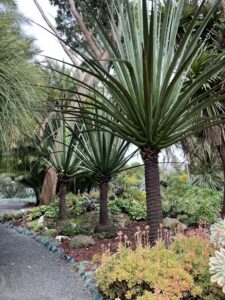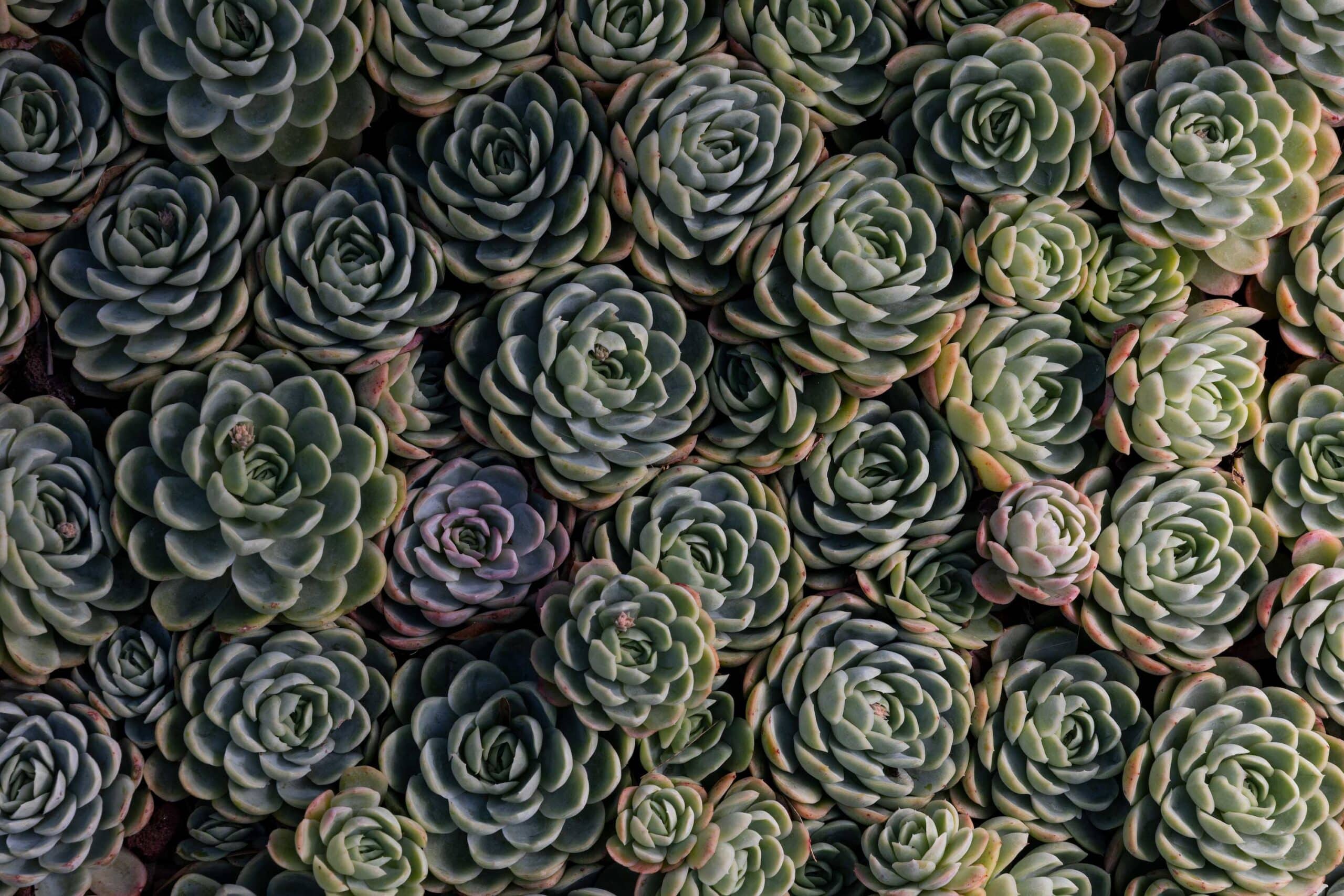
Plant Highlights
Plant Highlights
-
Doryanthes palmeri
giant spear lily
Highlight Month:
April
Nativity:
Australia: McPherson Ranges of southeast Queensland and northeast New South Wales. In habitat, it grows in evergreen forests on exposed rocky volcanic outcrops that experience frequent fires.
Growth Habit:
This species grows to large proportions with vertically furrowed 6-8’ tall leaves and makes for a dramatic feature in the garden. In the spring, plants produce large showy bent flower stalks, resembling large toothbrush heads, and display bright red cup-like flowers lined with white. Flowers later develop into a brown egg-shaped capsule filled with papery seeds. After flowering, the spent rosette dies but is replaced by numerous leaf rosettes emerging in the clump.
Growing Requirements:
D. palmeri thrives in full sun and will also grow in part shade where it may flower infrequently. It is drought tolerant once established and can handle nutrient-poor soils. Giant spear lilies do not require low-phosphorus fertilizers like many other Australian native plants. This species generally takes about ten years to flower when started from seed and is popular with birds seeking its abundant nectar.
Features:
The genus Doryanthes is endemic to eastern Australia and contains only two species in the family Doryanthaceae. The other species, D. excelsa, is similar in overall appearance but forms an erect inflorescence with a cluster of terminal red flowers. D. palmeri flower stalks and roots are a food source for Aboriginal Australians and the leaves are used to make ropes and woven products. The genus name comes from the Greek, doratos (spear) and anthos (flower), referencing the flowers found on the spear-like stalk. The specific epithet honors Sir Arthur Hunter Palmer (1819-1898), an Irish-Australian sheep farmer and politician.
Where at Lotusland:
Australian Garden and Main Lawn near entrance to the Lower Bromeliad Garden
-
Aloe sabaea
Yemen tree aloe
Highlight Month:
March
Nativity:
It is found in southwest Saudi Arabia and western Yemen and grows in a wide distribution on dry, rocky open hillsides.
Growth Habit:
Aloe sabaea is the tallest aloe from the Arabian Peninsula and its unbranched trunk can reach heights of 9-12 feet. Three-foot-long pale green leaves with small white marginal teeth emerge in drooping side-facing rosettes, imparting a melting appearance to the entire plant. When damaged, the leaves ooze a clear exudate smelling strongly of rat urine, indicating the presence of toxic hemlock alkaloids. This species blooms in mid-winter with coral orange flowers held on a branched inflorescence. Yellow-flowered forms exist but are rare in cultivation.
Growing Requirements:
Full sun, well-drained soils, hardy to 27°F
Features:
The specific epithet sabaea comes from the name for an ancient group of South Arabian people, the Sabaeans, who founded the Kingdom of Saba (800-400 BCE), in what is now present-day Northern Yemen and the Asir Province of Saudi Arabia. Researchers at Kew Gardens speculate A. sabaea evolved from a radiation event of Aloe into the Arabian Peninsula about 5 million years ago.
Where at Lotusland:
Aloe Garden
-
Chimonanthus praecox
wintersweet
Highlight Month:
January
Nativity:
Wintersweet is native to montane forests in central and southern China and has been cultivated there for over 1,000 years as an ornamental and medicinal plant.
Growth Habit:
C. praecox is a multi-stemmed deciduous shrub reaching 10-15’ tall by 8-12’ wide. In warmer climates, such as Santa Barbara, the sandpapery leaves tend to persist on the branches while flowering occurs from October to January. It can be pruned hard in late winter to reduce its growth and to allow for flower buds to mature on new branches in time for the following season.
Growing Requirements:
The plant is hardy to USDA Zones 6-7. Full sun to part shade.
Features:
As winter approaches, this nondescript shrub erupts in a display of delicate waxy yellow flowers with purple interiors. The scent perfumes the air in an intoxicating sweet aroma that can be detected before locating the plant itself. C. praecox is a member of the Calycanthaceae, or spicebush family. Other genera in this family include Idiospermum (native to tropical Australia) and Calycanthus (native to China and the United States). There is one species of Calycanthus native to California, C. occidentalis, or sweet shrub. Both Chimonanthus and Calycanthus produce a 2” long fruit in the shape of an elongated baby rattle. Once fully mature, the elliptic dry capsule opens on one end to disperse the brown seeds. The scientific name of wintersweet is derived from the Greek cheimon (winter), anthus (flower), and praecox (very early).
The flowers, leaves, fruits, and roots are used in Chinese folk medicine for treating colds, rheumatoid arthritis, and respiratory disorders. Essential oils derived from the plant are frequently used in cosmetics, perfumes, and for aromatherapy. The flowers can flavor herbal teas.
Where at Lotusland:
Wintersweet is located in the Arboretum at Lotusland adjacent to the Cypress Allée, where the flowers can be seen and smelled.
-
xCalibanus hookeri
Highlight Month:
November
Nativity:
Lotusland Origin
Growth Habit:
Calibanus hookeri forms a low-growing corky fully to semi-subterranean caudex that can reach epic proportions with reports of plants rivaling the size of a Volkswagen Beetle. It was rediscovered in the wild by a group of botanists, including Charlie Glass and Bob Foster, in 1968 before they both came to work at Lotusland. Beaucarnea recurvata forms a similar enlarged caudex many feet in diameter but the trunk can reach 20’ in height. Fruit from the hybrid plants displays three small papery fins, like the membranous wings on B. recurvata fruit, but is also rounded like C. hookeri fruit. The hybrids form base diameters rivaling B. recurvata and short trunks with multiple branches. Both species are native to Mexico but are separated geographically by hundreds of miles. Interestingly, the genus Calibanus has now been incorporated into Beaucarnea by some authorities (Rojas-Piña et al., 2014).
Growing Requirements:
Full to part sun, well-drained soils.
Features:
This spontaneous hybrid Calibanus has mysterious origins at Lotusland and is thought to be an intergeneric hybrid between Calibanus hookeri and Beaucarnea recurvata. Its story begins in the late 1970s when seed was collected from a female Calibanus hookeri in the Succulent Garden by Charlie Glass, Lotusland’s first unofficial curator. Calibanus and Beaucarnea are dioecious, meaning they produce male and female flowers on separate plants. Initially, Charlie presumed the resulting seedlings were pure Calibanus hookeri, but they started showing irregular characteristics, leading him to believe the plant may have been pollinated with a nearby male B. recurvata. Eleven of the seedlings were planted in the Cycad Garden in 1979-80 and a few were relocated to the nursery in 2010 to make room for a Dioon installation. One of these original plants remains in the Cycad Garden today next to a mature B. recurvata, making for a nice comparison. There are additional hybrid specimens in the Succulent Garden but without proper documentation it is unknown if these were from the original cross or were later propagations.
Where at Lotusland:
Succulent Garden, Cycad Garden
-
Aristolochia fimbriata
white-veined dutchman’s pipe
Highlight Month:
October
Nativity:
Bolivia, Paraguay, S. Brazil, Uruguay, and N.E. Argentina
Growth Habit:
This small Aristolochia displays charming maroon/yellow flowers with otherworldly fringed edges and rounded leaves featuring dramatic silver veins. A. fimbriata is native to Bolivia, Paraguay, S. Brazil, Uruguay, and N.E. Argentina. It is a food source for pipevine swallowtail butterfly caterpillar. The stems die back to an underground caudex during the winter but will spread to 2’ during the growing season as a groundcover. This plant can also grow as a specimen in a hanging basket or looks nice spilling over a rock wall. Because this species is deciduous, it is easy to control and will not take over the garden like other Aristolochia.
Growing Requirements:
This species is hardy to USDA Zones 7a to 9b and prefers shade but can handle morning sun.
Features:
The common name “dutchman’s pipe” refers to the flower shape resembling Dutch meerschaum pipes made from the clay mineral sepiolite. The genus Aristolochia comes from the Greek aristos, meaning “best,” and locheia, meaning “childbirth or delivery,” in reference to the flower resembling a human fetus in the womb. Species in this genus have also been used as an ancient Greek treatment for pain and infections related to childbirth. The flowers are pollinated by flies who become trapped in the long floral tube by downward pointing hairs. The following day, these hairs wilt and the flies are released covered in pollen to bring to another flower. The mature brown fruits resemble upside down parachutes filled with small triangular seeds.
Where at Lotusland:
Upper Bromeliad Garden
-
Ensete ventricosum
Abyssinian/Ethiopian banana, false banana
Highlight Month:
September
Nativity:
This large-scale banana is native to the eastern edge of the Great African Plateau.
Growth Habit:
E. ventricosum grows to 12-20’ in cultivation (30-40’ in habitat) and produces 10-12’ leaves that give a tropical look to the garden. Overlapping leaf petioles form a pseudo-trunk that expands at the base, hence the specific epithet, ventricosum, meaning “with a swelling belly.” This species rarely produces offsets from the base and will die after producing a dramatic inflorescence that takes over a year to develop. Small cream-colored flowers are hidden underneath maroon bracts with female/bisexual and male flowers occurring separately.
Growing Requirements:
This species is hardy to USDA Zones 10-11 but can be moved indoors for the winter in colder climates.
Features:
It is in the same family (Musaceae) as the more commonly cultivated banana but does not make palatable fruits. Instead, the heart of the plant is fermented to produce a variety of food products. The large black seeds are considered a famine food in Ethiopia and are also used to make beads.
Where at Lotusland:
Eight new plants of E. ventricosum were recently added to Lotusland’s Tropical Garden. All are seed propagations from a plant that flowered between August 2020-September 2021. The Water Garden is home to the red-leaved cultivar ‘Maurelii’, which is easier to find in cultivation than the straight species.
-
Salvia guaranitica
anise-scented sage
Highlight Month:
August
Nativity:
Brazil to Northern Argentina.
Growth Habit:
This large and attractive plant blooms mid-summer to fall with blue-purple petals and green to blue-black calyxes. The flowers are popular with hummingbirds and butterflies. Several cultivars available in the nursery trade have been selected for varying flower colors such as ‘Black and Blue’, ‘Argentine Skies’, and ‘Blue Enigma’.
This perennial Saliva can grow over 6’ tall in the Santa Barbara area but can be pruned in spring to branch at a lower height. Leaves are held in an opposite arrangement on the stem, are dark green in color, and have a mild anise-scent with crushed. Spreading underground rhizomes form a large patch and, in more temperate regions, can be overwintered indoors for planting the following season. Stem cuttings are also easy to root.
Growing Requirements:
S. guaranitica is hardy to USDA Zones 8-10, prefers full sun to part-shade, and is moderately drought tolerant once established.
Features:
The genus name, Salvia, comes from the Latin, salvus, meaning “to make safe or healthy” in reference to the healing properties of many sages. The specific epithet, guaranitica, refers to the Brazilian city of Guará, where this species is found.
Where at Lotusland:
At the back of the Cycad Garden.
-
Tradescantia sillamontana
cobweb spiderwort
Highlight Month:
June
Nativity:
Tradescantia sillamontana is native to dry regions of Mexico (Nuevo León).
Growth Habit:
This unique dry-growing Tradescantia has a delightful fuzzy leaf covering that resembles silvery cobwebs. Flowers are magenta and have three petals, typical of plants in the Commelinaceae or spiderwort family. This is a great specimen for containers, hanging baskets, or can be nestled in between rocks in a succulent garden.
Growing Requirements:
When grown in full sun it develops a compact habit and purple coloration to the leaves whereas plants grown in shade tend to be more elongated and greener. It is hardy to USDA Zones 7-10 and will die back to dormant buds in the winter. During this time watering should be infrequent.
Features:
This species was named in 1955 by Japanese-born Mexican botanist Eizi Matuda for Cerro de la Silla, a saddle or chair-shaped mountain, located adjacent to the city of Monterrey, Nuevo León.
Where at Lotusland:
This plant can be found at Lotusland in a pot in the Pavilion Patio and in the Succulent Garden.
-
Euphorbia caerulescens
sweet noor, blounoorsdoring, or blue euphorbia
Highlight Month:
May
Nativity:
E. caerulescens is native to South Africa where it grows in an area known as the Noorsveld.
Growth Habit:
It has a rhizomatous habit and forms a 5’ tall dense mass of blue-green segmented stems. The stems have 4-6 faces with rows of paired thorns that emerge brown and mature to grey. Bright yellow flowers standout against the blue stems and are followed by red fruits.
Growing Requirements:
E. caerulescens prefers full sun, well-drained soils, and is very drought tolerant. It is hardy down to 30°F.
Features:
The specific epithet, caerulescens, comes from the Latin, caeruleus, meaning sky-blue. Noors is the Afrikaans name for upright, spiny euphorbia plants. In habitat, local farmers use this species as livestock fodder. After being cut and allowed to wilt for a few days, the irritating latex sap found in the stems is rendered harmless.
Where at Lotusland:
Euphorbia side of the Main Drive
-
Furcraea macdougallii
MacDougall’s century plant
Highlight Month:
April
Nativity:
This Mexican Agave relative is native to Oaxaca, Chiapas, and Puebla where it grows in dry forests at elevations of 2,600 to 3,300 feet.
Growth Habit:
Mature F. macdougallii form a swollen trunk up to 15 feet tall topped with a rosette of thick dark green leaves reaching 7’ in length with curved marginal teeth. This species is monocarpic and will die after flowering. However, the dramatic 20’ inflorescence produces hundreds of bulbils (small plantlets) that can be easily propagated as clones of the parent plant.
Growing Requirements:
This species prefers full sun and has very low water needs.
Features:
F. macdougallii was first described by Eizi Matuda, a Japanese-born Mexican botanist who named this plant in honor of his friend Thomas MacDougall, a Scottish naturalist who studied southern Mexican flora for almost 50 years. MacDougall is credited with discovering this plant in the wild near Tehuantepec in Oaxaca.
Where at Lotusland:
At Lotusland there are three specimens of F. macdougallii near the intersection of the Succulent Garden and Blue Garden. These plants were donated to Lotusland from the International Succulent Introductions (ISI) 1965 distribution via the UC Santa Barbara Greenhouses and planted in 1995.


